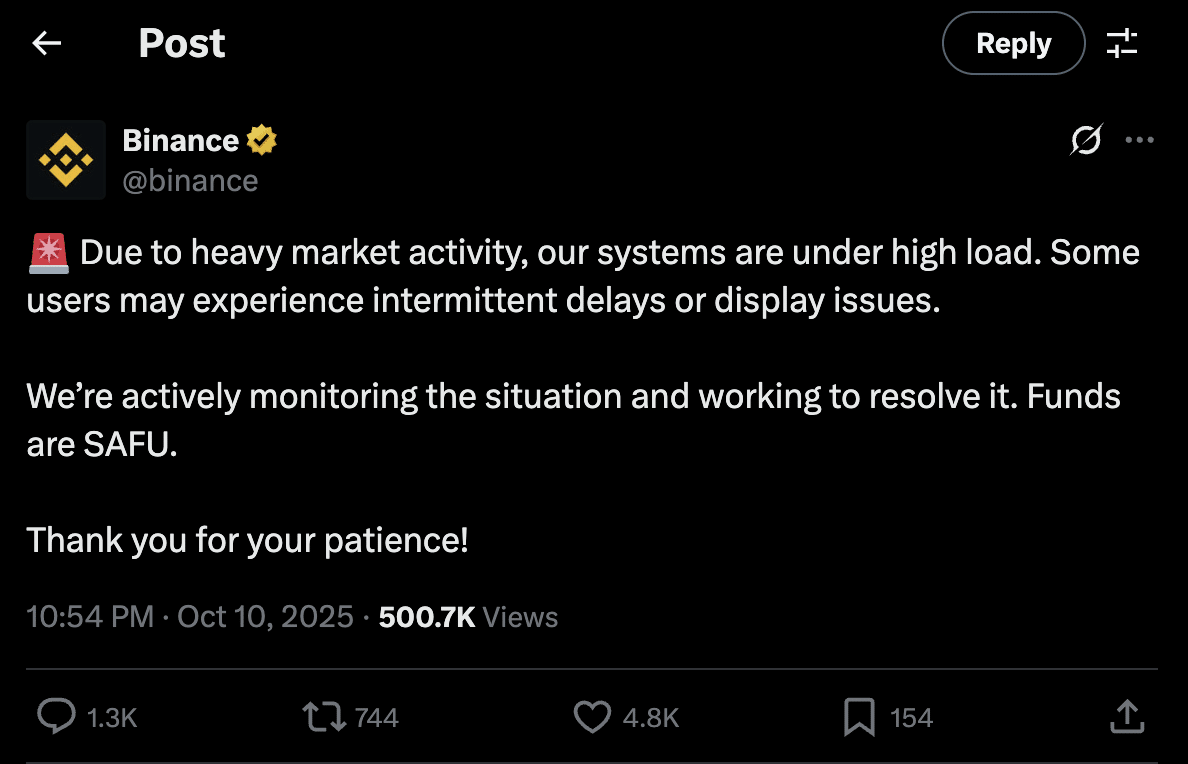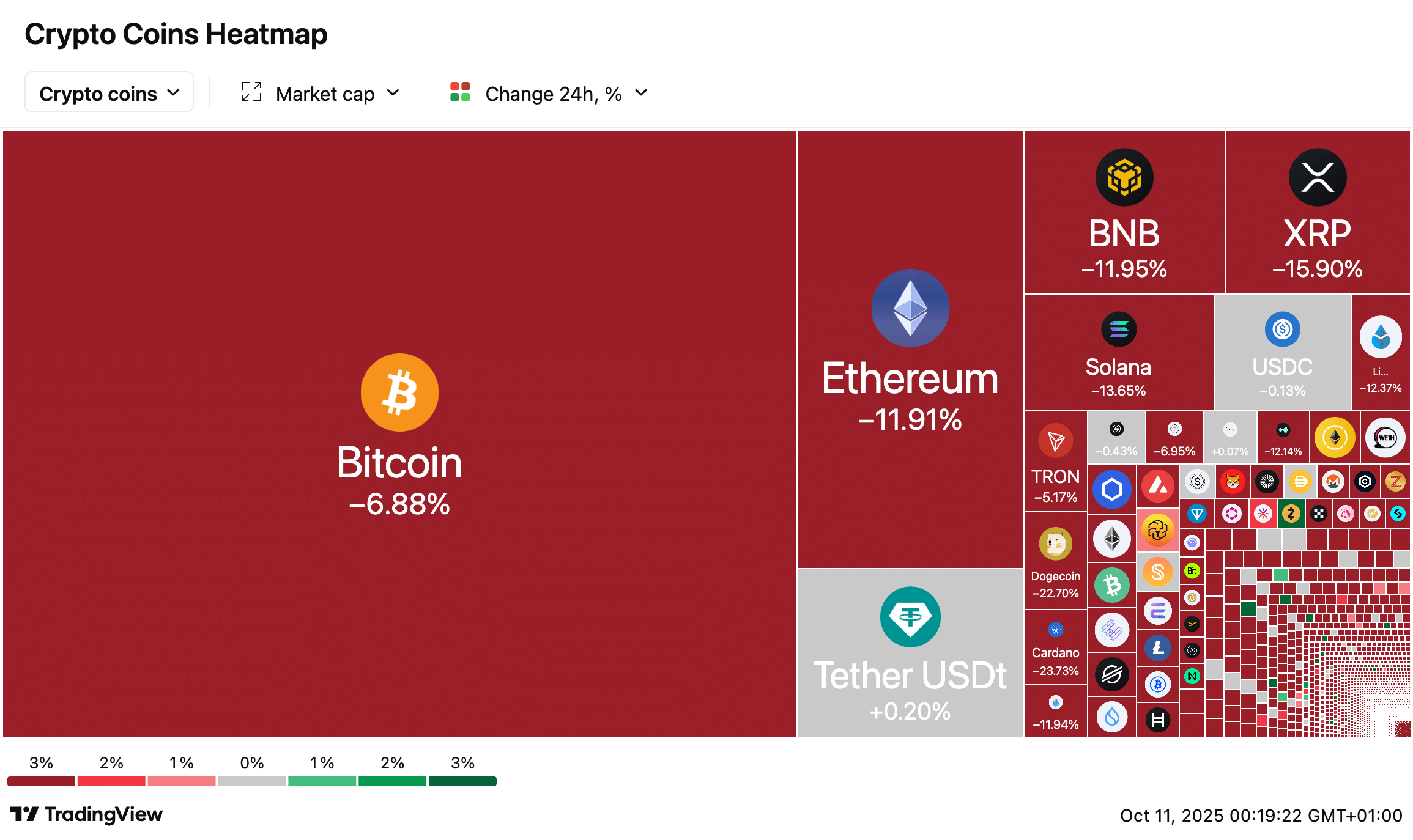Crypto exchange outages were triggered by a massive wave of sell-offs and over $9.5 billion in liquidations within 24 hours, which overwhelmed matching engines and caused latency, intermittent errors and delayed order execution across major platforms.
-
Over $9.5B liquidated in 24 hours
-
Major exchanges reported high load, latency and intermittent service interruptions.
-
Bitcoin fell ~7%, Ethereum ~12%; several altcoins plunged 20%+, deepening market stress.
Crypto exchange outages halted trading as $9.5B in liquidations hit markets—read how exchanges responded and how traders can protect funds now.
What triggered the crypto exchange outages?
Crypto exchange outages were caused by an intense sell-off and cascading liquidations that generated unusually high trading volume and API requests. Within 24 hours the market saw over $9.5 billion in forced liquidations, overwhelming order-matching engines and producing latency and intermittent errors on major platforms.
How did liquidations and volume trigger the outages?
Large leveraged positions were closed rapidly, creating spikes in market orders that exchanges struggled to process. Data from Coinglass shows roughly $8B in long liquidations versus $1.5B in shorts during the worst hours. That imbalance concentrated sell pressure and orderbook churn, producing extreme load on matching engines and market-data feeds.
Heavy volatility brings exchanges to a standstill
Bitcoin and Ethereum led the market decline, prompting traders to adjust positions simultaneously. The surge in orders increased API traffic, matching attempts and database writes beyond typical thresholds for many centralized exchange stacks.
Exchanges reported degraded performance. Binance noted systems were “under high load due to heavy market activity,” and Coinbase posted notices that some users may experience latency or degraded performance. Robinhood users reported trade delays and unresponsive charts; the platform has not issued a detailed timeline at publication.

Source: X
How severe was the market correction?
Price action was steep and broad-based. Bitcoin fell 6.88% and Ethereum declined 11.91% during the intraday move. Several major altcoins recorded double-digit losses; Cardano plunged 23.7% and Dogecoin dropped 22.7% as panic selling accelerated.

Source: TradingView
Why did centralized exchanges experience outages?
Centralized exchange platforms combine matching engines, risk systems and market-data feeds that must scale in tandem. When trading volume and API requests spike rapidly, back-end components such as orderbooks, databases and caching layers can become bottlenecked. Even with redundancy, cascading retries and client re-submissions further amplify load.
What role did macro factors play?
The correction coincided with a mix of macro pressures, including renewed U.S.–China trade tensions and risk-off moves in equities. Profit-taking after recent ETF optimism amplified selling. Together, these factors accelerated outflows and margin stress across leveraged positions.
How can traders protect funds during exchange outages?
Traders can reduce exposure and operational risk by diversifying custody and preparing contingency plans. Immediate steps include:
- Reduce leverage: Lower margin to limit forced liquidations.
- Use withdrawal readiness: Keep small reserve balances on alternative custodial or self-custody options.
- Set limit orders conservatively: Avoid aggressive market orders in high volatility.
- Monitor official exchange communications: Follow platform status pages and official channels for verified updates (platform posts and status pages are primary sources).
Frequently Asked Questions
How long did the outages last?
Intermittent slowdowns and latency were reported across platforms during the peak hours of the sell-off. Many services restored normal performance within hours as matching loads eased and exchanges scaled back-pressure systems.
Did the outages affect withdrawals?
Most platforms reported that custodial balances were secure, though some users experienced delays in processing withdrawals and order executions until systems stabilized.
Key Takeaways
- Liquidations drove the stress: Over $9.5B in liquidations concentrated sell pressure and API load.
- Exchanges saw degraded performance: Major platforms reported latency and intermittent errors during peak volumes.
- Protective steps exist: Reduce leverage, prepare withdrawal options, and use conservative order types to limit risk.
Conclusion
The recent crypto exchange outages show how concentrated liquidations and high-frequency order flow can exceed platform capacity and produce operational risk. Market data from Coinglass and TradingView confirm the scale of liquidations and price declines. Traders should apply risk-management measures and monitor official exchange communications as markets settle. COINOTAG will continue to update this report as more information becomes available.





